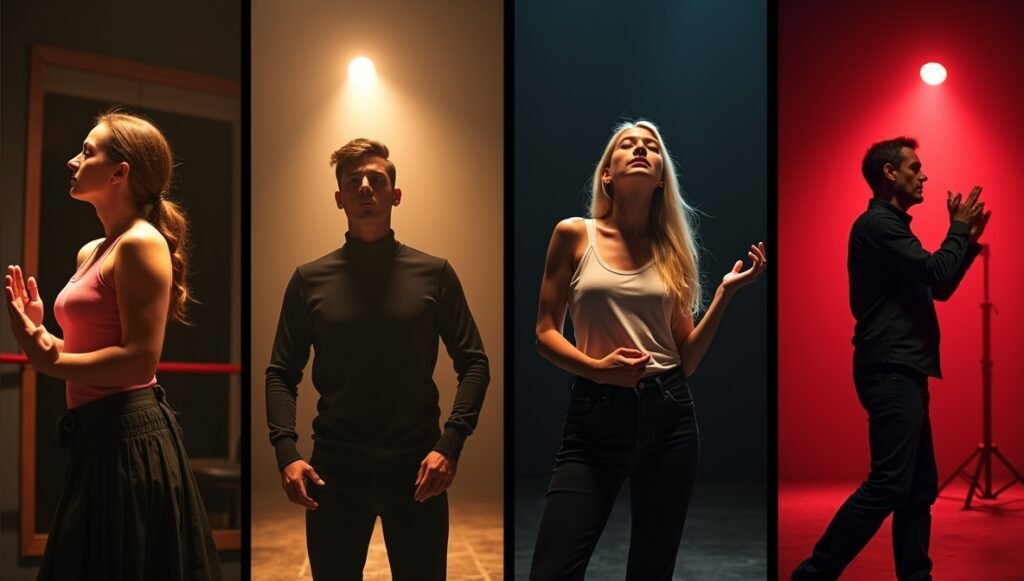Performance anxiety—often called stage fright—is the invisible co-star every actor meets eventually. Its symptoms range from mild butterflies to trembling knees, runaway heartbeats, and total mental blanks.
The good news? Stage fright is manageable, and it can even fuel sharper, more compelling work when handled correctly. Below are practical strategies you can deploy the very next time you step into the spotlight.
Each section offers clear explanations, evidence-based tools, and quick-reference bullet points so you can convert nervous energy into artistic fire—fast.
1. Understand What’s Really Happening

Anxiety feels mysterious, but it’s simply the body’s ancient fight-or-flight response misfiring in a modern, non-dangerous context. Your brain releases adrenaline; heart rate, breathing, and muscle tension spike to prepare for battle or escape. Because acting requires fine motor control and mental flexibility, those same survival reactions can sabotage performance if unchecked.
Knowing the biology helps you detach from fear. Instead of thinking, “Something is wrong with me,” you can tell yourself, “My sympathetic nervous system is over-activated, and I have tools to dial it down.” Reframing the experience turns the problem from a character flaw into a technical hurdle.
- Name the feeling (“adrenaline surge”) to reduce its power.
- Remind yourself the symptoms are temporary and common.
- Decide to use the energy rather than fight it.
2. Reframe Anxiety as Excitement
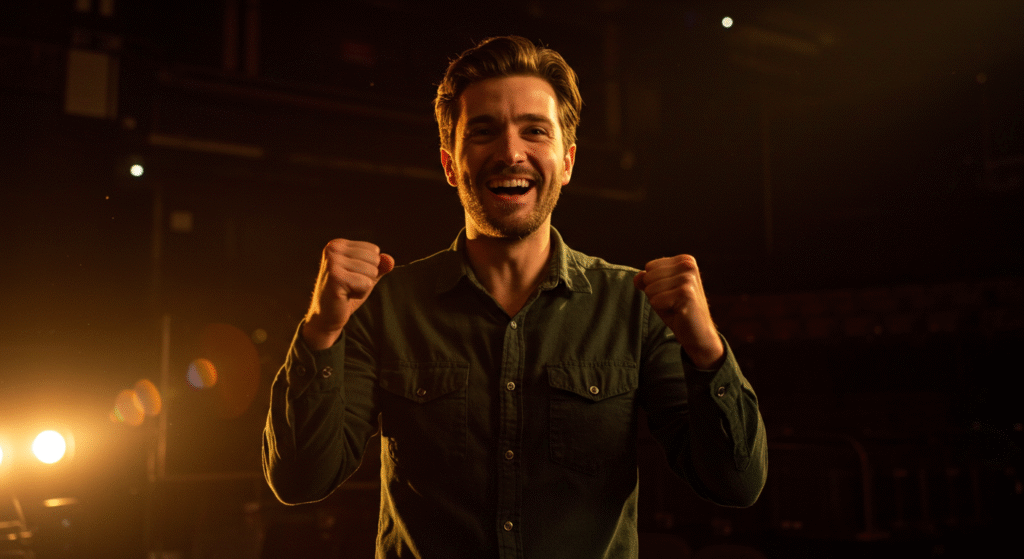
Psychological studies show it’s easier to flip anxiety into excitement than to force total calm. Both emotions involve high arousal; the difference is interpretation. Before going on, tell yourself, “I’m excited to share this story,” instead of, “I’m terrified I’ll mess up.” The language cue shifts your mindset without demanding an unrealistic state of serenity.
Train this reframing away from the theater. When you feel nervous—before a job interview or a sports event—practice saying, “I’m energized.” Your brain will learn that adrenaline equals opportunity, not doom.
- Replace “nervous” with “excited” in self-talk.
- Visualize applause or positive feedback as the reason your heart races.
- Smile (even briefly) to signal the brain that things are safe and joyful.
3. Master the 4-7-8 Breath
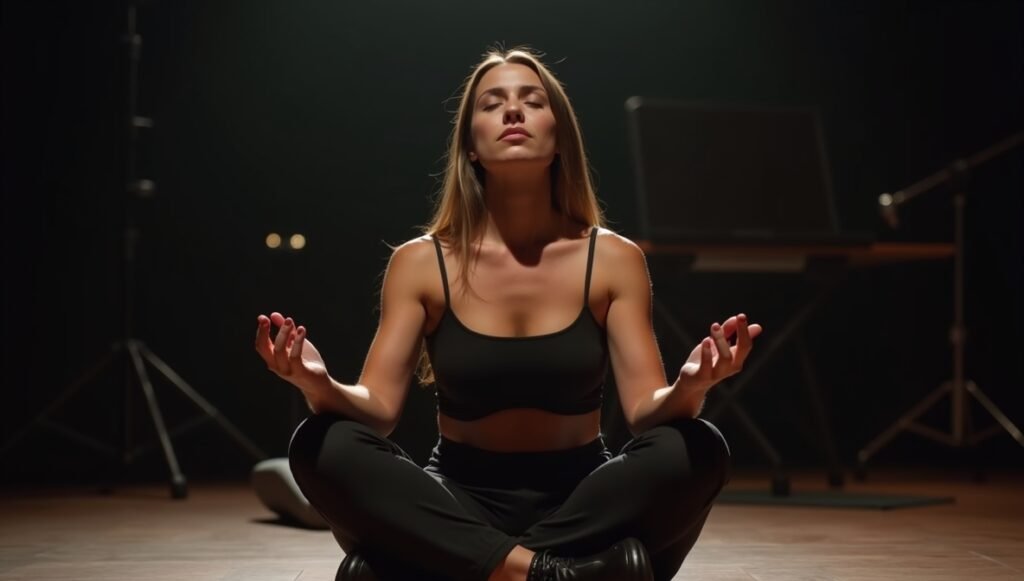
The fastest physiological lever you can pull is controlled exhalation. Dr. Andrew Weil’s 4-7-8 method slows heart rate in less than a minute:
- Inhale through the nose for 4 counts.
- Hold for 7 counts.
- Exhale audibly through the mouth for 8 counts.
- Repeat four cycles.
As carbon dioxide rises, the parasympathetic nervous system kicks in, counteracting adrenaline. Actors like this pattern because it also supports diaphragm engagement, the engine of healthy projection.
- Practice twice daily so the rhythm feels automatic.
- Use discreetly backstage—nobody notices silent counting.
- Pair with a grounding phrase (“Breathe, release, perform”).
4. Ground the Body Before the Mind

An anxious brain lives in the future: “What if I forget my line?” Grounding yanks attention into the present physical world. Stand with feet hip-width apart, bend knees slightly, and feel the floor through each toe. Press down and imagine roots growing from your soles into the stage boards. This image stabilizes posture and reduces shaky legs.
Add gentle muscle shakes—arms, jaw, shoulders—to discharge excess tension. Olympic sprinters do similar “shake-outs” right before the start gun; it primes muscles for responsive action rather than frozen stiffness.
- “Root” the feet for ten full breaths.
- Shake each limb for five seconds, then let it hang loose.
- Finish with one deep sigh to release residual tightness.
5. Develop a Repeatable Warm-Up Ritual

Ritual teaches the brain: “We’ve done this before, and it ended well.” A reliable sequence—perhaps five minutes of vocal sirens, five minutes of spinal rolls, and one minute of tongue twisters—creates a bridge from daily life to performance mode. Because the order never changes, each step cues the next, occupying mental bandwidth that would otherwise host worry.
Keep the ritual short and portable; you might not have a private dressing room on every gig. Consistency beats complexity.
- Pick 2-3 voice exercises and 2-3 physical stretches.
- Use the same playlist or tempo each time for Pavlovian effect.
- End with a brief visualization of your first entrance.
6. Visualize Success in High Definition

Mental rehearsal isn’t fluffy “positive thinking.” Functional-MRI studies show that imagining an action lights up nearly the same neural circuits as doing it. Close your eyes and run your scene like a film: See the set, feel stage lights warming your skin, hear your voice resonating clearly. Importantly, visualize overcoming small stumbles—taking a breath, staying in character, and continuing flawlessly.
This prepares the mind for real-world variables: a tardy entrance cue, a dropped prop. When glitches occur, your brain says, “We’ve navigated this,” rather than triggering panic.
- Practice imagery in the actual venue whenever possible.
- Engage all senses: sight, sound, touch, smell.
- Keep sessions under five minutes to avoid mental fatigue.
7. Anchor Attention Outside Yourself

Anxiety spirals when focus narrows to internal judgment: “Everyone sees my hands shaking.” Shift attention outward—to your acting partner, to an on-stage objective, or even to an imaginary target on the back wall. Pursuing goals within the story overrides worry about self-image.
Teachers call this task focus. It’s why a fencer concentrating on an opponent’s blade rarely feels stage fright mid-bout; the mind is busy tracking objectives. Actors can mimic this by treating each line as a tactical arrow aimed squarely at another character.
- Memorize clear action verbs for every beat (to persuade, to deflate, to charm).
- Lock eyes with your scene partner for the first five lines to cement connection.
- If solo, use focal points in the balcony to “speak to” rather than “perform at” the audience.
8. Use Thought-Stoppers for Negative Loops

Sometimes intrusive thoughts break through: “I’m blanking on my monologue.” Create a quick “thought-stopper”—a word or gesture that interrupts the spiral. Some actors snap a finger, others whisper, “Reset.” Follow immediately with a grounding action like shifting weight or inhaling deeply.
Thought-stoppers work because the brain can’t multitask; a simple physical cue creates a micro-gap in the anxious narrative, giving you space to insert a productive tactic (e.g., recall the emotional objective instead of the exact next word).
- Choose a discreet cue you can trigger mid-performance.
- Rehearse during run-throughs so it feels natural.
- Pair with a positive anchor phrase (“Back in the scene”).
9. Leverage Environmental Familiarity
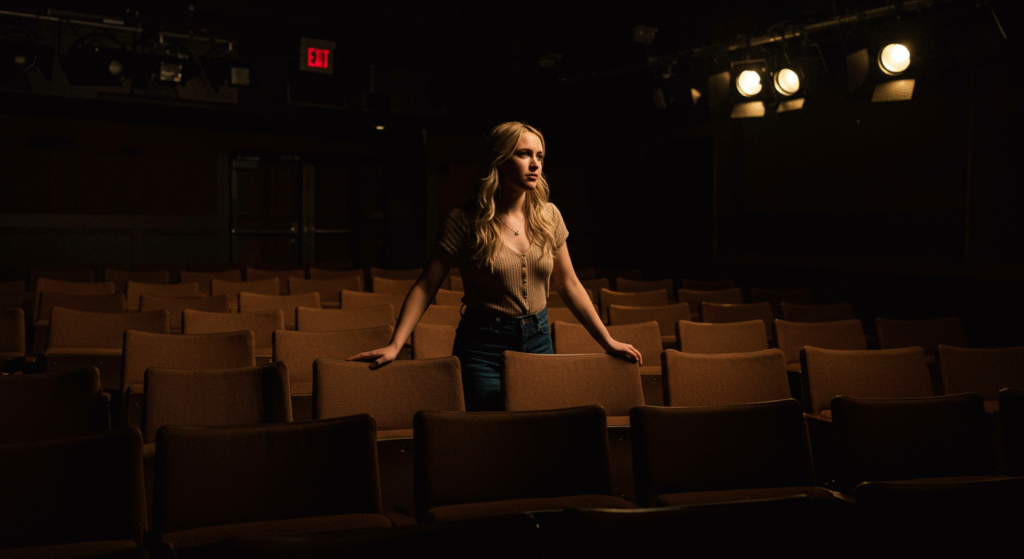
Walking onto a dark stage for the first time on opening night is a recipe for jitters. Arrive early, explore the wings, test sightlines from downstage right, clap once to hear the room’s resonance. Each sensory imprint lowers novelty, and the brain equates novelty with potential threat.
If travel prevents a physical visit, review floor plans or photos and visualize blocking in that space. Your senses will feel less ambushed when the curtain rises.
- Run key blocking marks during tech rehearsal with full lights.
- Sit alone in the house for a minute to “meet” empty seats.
- Test props in costume to avoid surprises (slippery goblets, noisy bracelets).
10. Support Your Nervous System Offstage

Quick fixes work best on a foundation of good habits. Regular aerobic exercise metabolizes cortisol; balanced meals prevent blood-sugar crashes that mimic panic; eight hours of sleep consolidates line memorization, freeing mental bandwidth on performance day. Caffeine may heighten jitters, so experiment with half-caf or herbal tea leading up to curtain.
Mindfulness practices—ten minutes of daily meditation or even quiet nature walks—train baseline parasympathetic tone, making it harder for the stress response to spike.
- Schedule workouts 24 hours—not two hours—before showtime to avoid fatigue.
- Eat complex carbs and lean protein two hours prior; avoid heavy sugar.
- Keep hydrated; dry mouth is a common panic symptom and vocal hazard.
11. Seek Coaching or Therapy When Needed
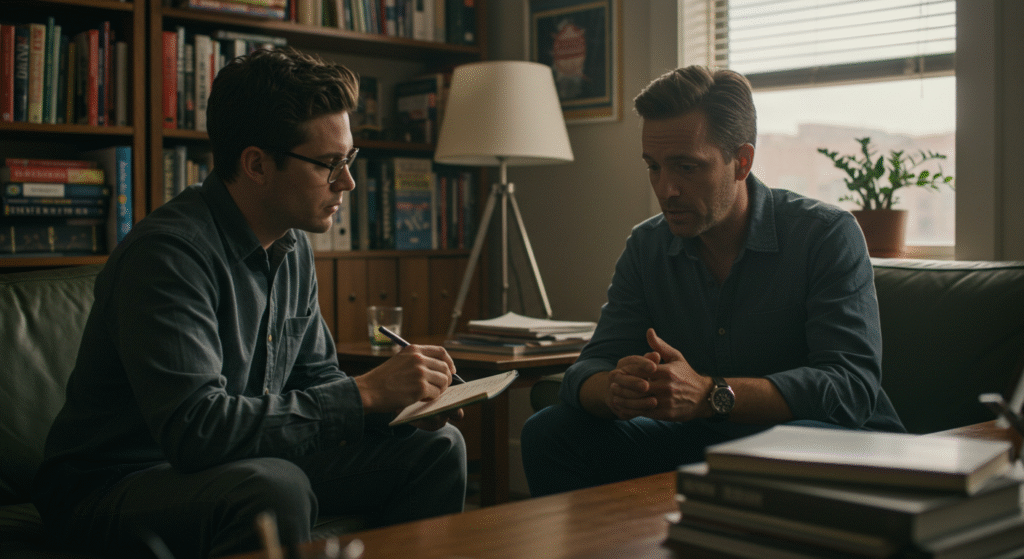
Persistent or debilitating stage fright might signal underlying social-anxiety disorder. Performance coaches can provide targeted desensitization drills, while licensed therapists offer cognitive-behavioral therapy (CBT) or acceptance-and-commitment therapy (ACT). Both modalities boast high success rates in reducing performance anxiety.
Remember: seeking help is not weakness; it’s professional maintenance—no different from seeing a physical therapist for chronic knee pain.
- Look for therapists familiar with creative-arts clients.
- Combine CBT with gradual exposure—open mic nights, small showcases.
- Consider beta-blockers only under medical supervision; they mask symptoms but don’t build coping skills.
12. Debrief to Build Resilience

After the curtain call, resist sprinting away from any imperfections. Take five minutes to note what worked—“breath reset before Act 2 entrance”—and one or two adjustments—“ground feet more during final monologue.” This turns anxiety events into data for growth, reducing fear of the next show.
Celebrate victories, even micro ones. Dopamine reinforces the learning loop, teaching the brain that performance equals reward, not danger.
- Keep a small rehearsal journal in your gig bag.
- Ask trusted colleagues for one positive, one constructive note.
- Revisit notes before the next call to cement progress.
Final Curtain
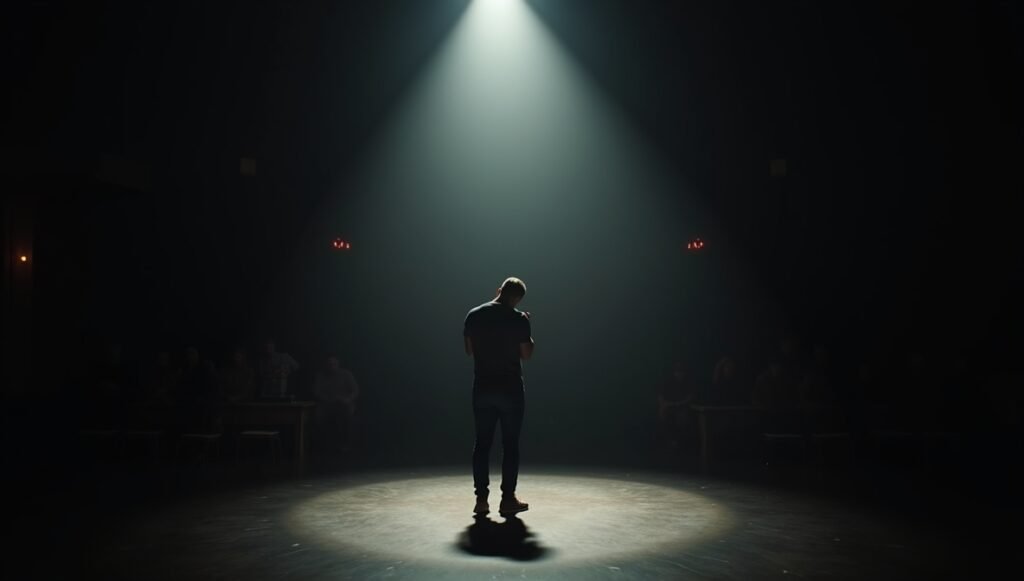
Stage fright is less a dragon to slay than a wild horse to ride. With biology-friendly breathing, strategic mindset shifts, and grounded rehearsal habits, you can transform jittery energy into magnetic stage presence—often in minutes. Master these tools, and the next time your heart pounds under the lights, you’ll smile, call it excitement, and let the performance gallop exactly where you intend.
Quick-Glance Toolkit
- 4-7-8 breath cycles backstage
- Root-and-shake body grounding
- Two-minute high-definition visualization
- Action-verb focus on partner or objective
- Thought-stopper cue + anchor phrase
- Consistent warm-up ritual
- Post-show micro-debrief for continuous growth

